Creating a Course Blueprint
| Site: | Technology-Enabled Learning Lounge |
| Course: | Developing & Teaching Online Courses |
| Book: | Creating a Course Blueprint |
| Printed by: | Guest user |
| Date: | Sunday, 4 January 2026, 8:16 PM |
Description
This book will guide you through the creation of a course blueprint using this template. Please save the template to your own computer as you will be asked to update it with new information as you go through this section of the course.
Assessing the Need and Profiling the Audience
Having a good idea as to whether or not there is need and demand for a particular course and learning about key characteristics of your potential learners are important elements to keep in mind when designing and creating a new course from scratch. Why, you may ask... well, if there's no need for the course, chances are there won't be many people taking it, so you may want to refocus your energy on courses that will benefit a larger, cross-section of the learning population. And when you know the key characteristics about your learners, you can design your course to meet their specific needs, which in turn will generate more positive and meaningful learning experiences.

Example
If you know that your learners are mostly female, married with children living in the suburbs, graduates from highschool who speak English, have some work experience in administrative positions and have good access to the Internet, as you can see in this Wordle:
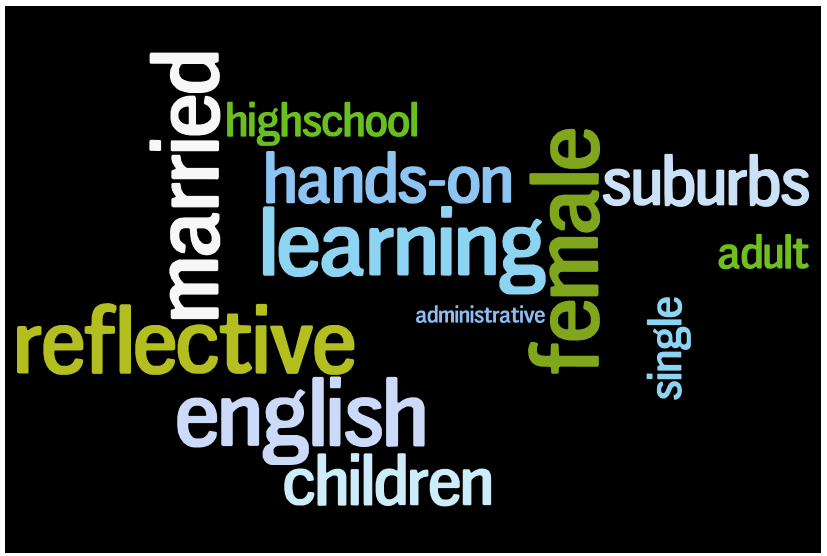
Then you are probably better off designing a course that will offer some flexibility, perhaps using a blended model (online with some face-to-face sessions) so that learners don't have to attend classes every day and don't have to arrange for childcare. Your content may include examples that are taken from administrative tasks and, since they are adult learners as opposed to children or youth, you will use different language and engage them in different activities.
However, if you are adapting content from an existing course for online of blended delivery you may not need to spend time collecting information about the need for the course nor the potential learners. In fact, chances are you may already have that information, either because it was given to you or because you have been teaching the course in the classroom and you know these elements already. In this case, you may want to skip to the section about course intent, as the next pages may not be of much interest to you.
Why Is Your Course Needed?
So, either you are thinking of creating an online or blended course, or you have been tasked to do it. Before you jump right into it, have you thought about why your course is needed?
- Could it be because it is part of a training or education program?
- Could it be because it will address a performance issue?
- Could it be because it will address specific knowledge or skill gaps?
- Could it be because a new system or technology has been introduced in your organisation?
Knowing why your course is needed will help you make decisions about what content to cover and to what extent it needs to be covered. It may also provide you with some clues to determine when the course is needed, who are the stakeholders involved in the project and whether or not some resources already exist.
Gathering information on why your course is needed is part of what we call a needs analysis. In simple terms, you try to find out as much background information about the need for your course as possible.
Gathering the Data
To be able to analyse why your course is needed you may:
- gather up existing data through reports, minutes of meetings, or any other available internal documents related to the course creation;
- chat with anyone who may have an interest in the project; this can be a chat with your peers, managers, colleagues in other departments, colleagues in partner institutions;
- gather up your own observations as to why the course is needed.
The process of gathering data for a needs analysis can be very formal, extensive and time consuming, requiring the use of complex survey instruments; or it can be informal, narrowly focused and quick, requiring only informal conversations. It depends on the scope of the project and the institutional requirements.

Examples
Questions you may want to include in an informal conversation:
- How did the idea for the course come about?
- Who was involved in the initial discussions about the course?
- What needs will this course address?
- Why do you think this course is needed?
- What will be the impact of this course?

Activity
Take some time now to think about the course you want to develop and write a brief description of your course in the course blueprint document, fill in the information about the course name and save the file to your hard drive.
Who Are Your Learners?
Before you begin to design your course, it is important to collect information about your potential learners. Knowing key characteristics of the learners who may sign up for your course will inform your design so that the course is relevant and contextual. For example:

Examples
- If you know ahead of time that your course is aimed at high school graduates, you will design learning activities that are geared towards a younger audience, such as webquests.
- If you know ahead of time that your learners have low literacy levels, you will write your content using simple sentence structures and vocabulary.
- If you know that your learners live in rural remote areas, you are less likely to design learning activities that will require going to a library.
Learner Data
Learner data that you may want to collect include:
- Demographic data (age, gender, ethnicity, language)
- Geographical dispersion (where your students are located)
- Prior knowledge and skills (what level of education your students have, what professional development courses they may have taken, and in what areas)
- Prior experience (previous jobs or activities)
- Access to and familiarity with technology (access to a computer, the Internet, CD-ROMs, etc.; how familiar they are with using technology)
Finding Learner Data
The best way to collect data about your potential learners is through a survey or focus groups. However, more often than not there is no time (nor budget) to prepare and send out a survey or to organise a focus group. In this case, you can rely on:
- Your own knowledge of the audience and the community
- Conversations with peers and managers that will allow you to infer some of the key characteristics of the learners
- Data that may be available about the course you are to design, such as the intent and what specific need it will address
- Online searches
The important thing at this point is that you stop to think about the key characteristics of your learners and draft what we call an audience profile.

Example
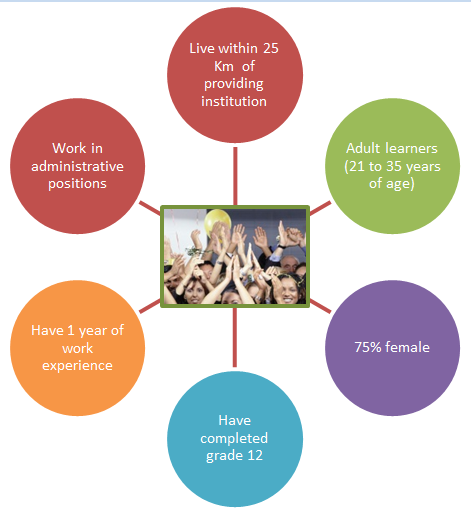

Activity
Think about the key characteristics of the potential audience for your course and create a bulleted list in the Audience Description section in the course blueprint document indicating gender, prior knowledge, age, etc.Why Needs Analysis and Audience Profiling?
So far you did an analysis of the need for your specific course and you created an audience profile of your potential learners. But why is it important to do that? Why not get started with putting the course together right away? After all, we are always short of time!
Well, having a good idea of why the course is needed and who the audience for the course may be will influence not only the design of the course, but also the media selection and the learner support strategies that will have to be implemented to support learners to be successful.
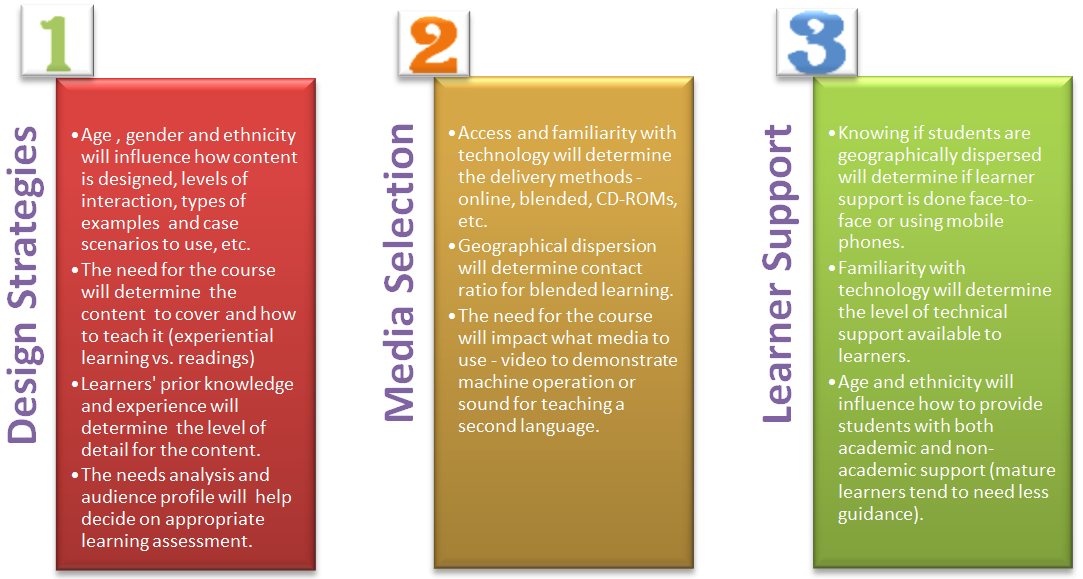
Course Intent and Alignment
The alignment between the essential intent of the course, learning objectives, learning activities and learner assessment guides your designing work to ensure a meaningful learning experience. When these course components are properly aligned you know that you are teaching the content that you need to be teaching, that you are providing learners with meaningful activities that create opportunities to practice concepts learned and, most importantly, that you are assessing only content that has been covered and with which students have had an opportunity to interact.
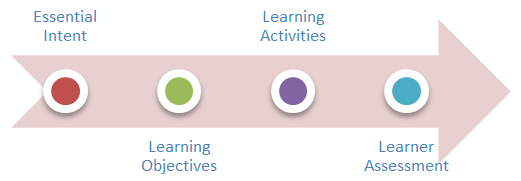
Without this alignment you might teach topics that are not necessary, provide activities that are irrelevant to the learning process and, more gravely, you might assess learners on topics that may not have necessarily been covered. The latter can cause serious issues with learner motivation and engagement as well as administrative chaos as learners may challenge exam results or final grades... and rightfully so.
This chapter focuses on determining the essential intent for a course and aligning the various course components. If you are adapting an existing course for online or blended delivery, you may want to go through the course content to check for alignment between the objectives, activities and assessment. This may be the time to make some changes and improve on what already exists!
Determining Essential Course Intent
The essential intent for your course will be a high level statement that describes the knowledge that learners will demonstrate upon completing the course. The course intent should be broadly stated, meaningful, achievable and assessable.
Let's say that you have to develop a course on Vehicle Maintenance for an Auto Mechanics program. Here is an example of a statement that indicates the essential intent of the course:
Example
- Formulate a vehicle maintenance plan to meet specific vehicle needs and manufacturer requirements for warranty compliance.
Notice how the statement includes an action verb that implies a broad body of knowledge. The essential intent of the course should state comprehensive learner behaviours as they indicate what the student will learn during the entire course.

Activity
Write a statement that indicates the essential intent for your course in the Course Intent section of the course blueprint document.If you are adapting a course, you may already have this statement. Have a critical look at the existing statement to see if it can be improved.
Essential Intent and Learning Outcomes
The essential intent of a course provides the framework for determining the related learning outcomes. The learning outcome statements are specific and have a narrower focus as they determine what behaviours learners are supposed to demonstrate at the end of a specific section. The learning outcomes must be in aligment with the essential intent of the course. Let's take the course intent statement from the Vehicle Maintenance course. Notice how there are several specific learning outcomes that students will have to demonstrate in order to satisfy the intent of the course:

So there is a clear hierarchy between intent and outcomes. Depending on how you will sequence your content, you may have broader outcomes for a module and more specific ones for lessons within a module. We will look at this hierarchy in more detail in the Planning Your Course section.
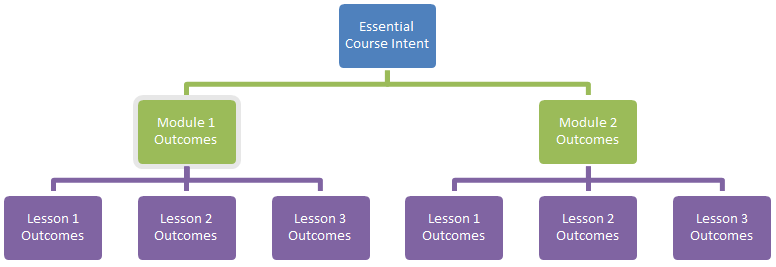
Essential Intent and Assessment
Let's take the essential intent statement for the Vehicle Maintenance course as an example. Notice how it guides the assessment strategy for the course:

As you see, once the essential intent of the course is established, the assessment strategy is easy to define and align with the course intent. In the case of the Vehicle Maintenance course, the assessment strategy could include a two part submission of a vehicle maintenance schedule as well as one or two quizzes throughout the course.
By closely aligning the course intent with the assessment strategy we create an assessment plan that ensures students are fairly and equitably assessed.
Assessment and Learner Support
The assessment strategies you identify for your course will have an impact on the learner support that will be required to ensure positive learning experiences and support learner success.

Examples
In a blended carpentry course:
- If the final learner assessment relies on demonstration of skills, it may have to take place in a 'shop'. Therefore, you will have to make sure there are enough facilities and equipment available.
- If formative learning assessment will rely on online discussions, you have to make sure that there are enough tutors with time to facilitate the discussions. This will have an impact on human resources as well as budgets.
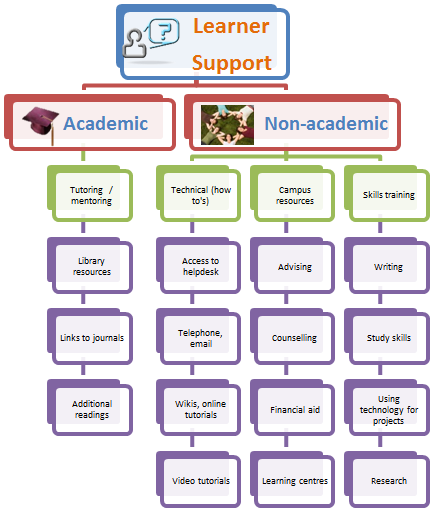
Planning assessment strategies has implications on the requirements for learner support. It is helpful to start thinking about all this as you move on to the planning stage to make sure that your course design is implementable and sustainable.

Web Resources: Optional Reading
The NADEOSA quality criteria for learner support are a very good resource to guide you through the requirements for good learner support for online learning.
Course Assessment Strategy
Creating a course assessment strategy closely aligned with the essential intent of the course will serve two purposes:
- It will give you a good idea as to whether your learners are in fact learning.
- It will create opportunities to provide learners with feedback to guide them through the learning process.
Therefore, it is important to create opportunities for multiple assessments throughout the course, at regular intervals. Assessing learner knowledge regularly helps learners pace themselves while consolidating their learning; it also gives instructors an idea of how well students are doing and provides valuable opportunities to provide feedback and remediate learning if necessary. This is what we typically call formative assessment. If learning assessment only occurs at the end of the course (summative assessment) there will be no opportunities to provide guidance to support learners to succeed in the course.
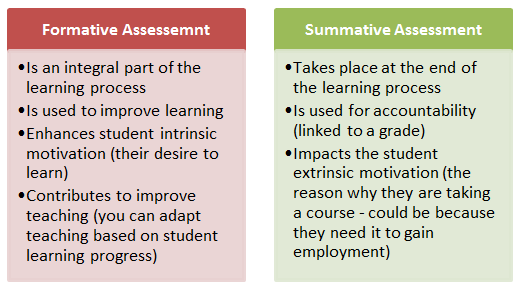
Defining a Course Assessment Plan
To define an assessment plan for your course, think about the essential intent of the course and what assessment events would best demonstrate student learning. As you saw in the example of the Vehicle Maintenance course, we determined that a two phased submission of a vehicle maintenance schedule would best demonstrate student knowledge, supplemented by a couple of quizzes. The assessment strategy for your course will depend on the course content, your learners and what you are trying to achieve with your course.
It is also good practice at this time to determine the weight and grading of each assessment event based on how comprehensive they are and whether they are cumulative or not.
Make sure you consider the duration of your course as you decide on the number of assessments that will best demonstrate student learning. Although you should aim to keep the workload "doable" for the student, you should also ensure that there are multiple assessments to give students the opportunity to recover their grades if they write a 'bad' exam, for example. Here is an example of an assessment plan:

Example
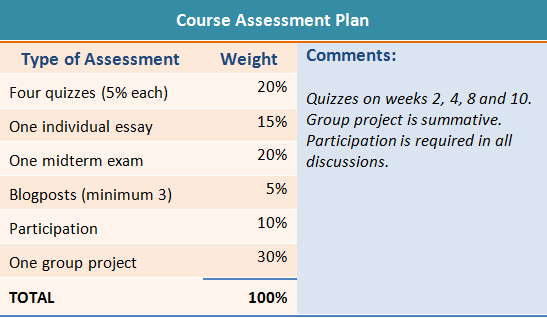

Activity
Update the Assessment Plan section of the course blueprint file with information about an assessment plan for the course you are designing.
Learner Support Strategy
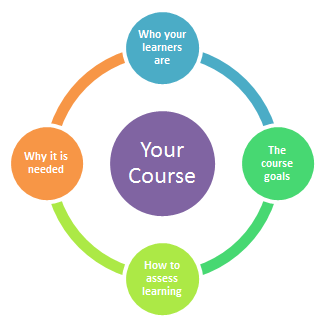
Now that you know the essential intent for your course, who your learners are and how to assess student learning, you are ready to start making decisions about course delivery and how you will support your learners through the learning process.
Course Delivery Modes
When you decided to develop your course, you may have started out with pre-conceived ideas about how to make it available to students: fully online, through the Internet, or in a blended environment, with some sessions delivered online supplemented with a number of hours of classroom interaction. However, the information you gathered up until now about your audience, as well as the technical and physical infrastructure and budget available to you, and the strategic direction of your institution should inform your final decision.

Examples
If you are designing a course to upgrade Carpentry skills, you may want to consider a blended delivery model in which you may offer some of the theory online and allocate a minimum number of hours for hands-on learning in a carpentry shop. Then you need to consider your audience profile: if your learners are widely dispersed geographically, you may need to either consider having them travel to a community shop, in which case you will have to establish some community partnerships and offer some training, or you will have to consider having your instructors travel to local communities to deliver and support the experiential learning. As you can guess, these two options will have different impacts on your budget and on how you will design your course.This may seem a bit overwhelming to you right now, but rest assured, now is the time to think about it. Doing some thinking ahead and some planning will guide course design decisions further on. Like building a house: you don't start building before you have the architectural drawings that will guide the construction.

Activity
Update the Delivery Modes section of the course blueprint file with information about how the course you want to develop may be delivered.
How to support your learners should be an integral part of your conceptual planning process. An effective learner support strategy will impact the quality of the teaching and learning, and it will also impact your budget. Let's look at the two main categories for learner support next.
Types of Learner Support
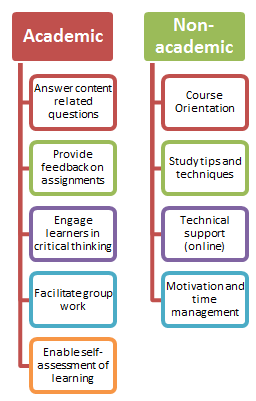
When planning a learner support strategy make sure that it includes two levels of support, sustained by a variety of tactics, specific to your delivery context.
Some of these tactics may be fairly easy to implement and may not require too many resources. For example, academic support to enable self-assessment of learning may only require careful planning and design of self-assessment activities and investing in a set of good learner instructions. On the other hand, other tactics may require additional infrastructure. For example in the case of blended learning you will most likely need a room to facilitate the face-to-face sessions. In the case of online learning, it is extremely important that your students have access to a help-line to help them troubleshoot technical issues.
What is non-negotiable in terms of learner support, is that your students receive appropriate and timely feedback on their assignments. Therefore, any delivery mode must contemplate ways in which students can submit their work (by email, by mail, by telephone, etc.). Any learner support strategy must include a number of hours for instructors to provide guidance and feedback.

Activity
Update the Learner Support Plan section of the course blueprint file with information about learner support plan for the course you are designing.
The Role of the Instructor
When teaching online and blended courses instructors wear many hats. One of the first "hats" they wear is that of the course author, as they design and write content, prepare learning materials, design learning activities, etc. This is most likely the role that you are playing right now, as you have been tasked to design and develop a course. Course designers and authors play a role in the quality of learner suppport by including in their materials:
- Clear guidance on where to begin the study and what do do next
- Clear instructions for learners in regard to activities, group projects, etc.
- Clear indication of how learners will be assessed
- An engaging and conversational style of writing, guiding students through the content and the learning activities
Once the course is developed and it comes time to teach it, course authors may or may not be the instructors. If they are, they will have to change "hats" to become facilitators of learning, which encompasses the following roles:
- Pedagogical - when wearing this hat instructors engage learners in stimulating discussion and sharing their experiences, pose probing questions, provide students with feedback on activities and assignments and guide them through the learning process.
- Social - when wearing this hat instructors engage in inter-personal communication with learners, providing affective support aimed at keeping learners motivated.
- Managerial - when wearing this hat instructors oversee projects and activities, grade assignments, structure group work, provide a course schedule and advise learners on time management and study skills.
- Technical - When wearing this hat instructors guide in the use of the technology used in their course and direct them to available technical assistance as needed.

Optional Reading Activity
If you are interested in reading more about the role of the instructor in online learning, this chapter from the "Online Tutoring e-Book" from Higginson and Cornelius offers effective strategies for consideration.
Assignment
By now you should have completely filled out the course blueprint for your course, so go ahead and submit for feedback at the Course-blueprint dropbox.